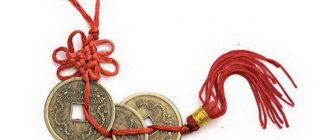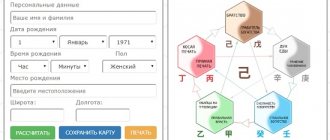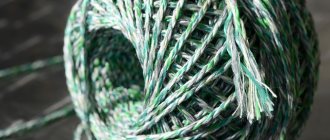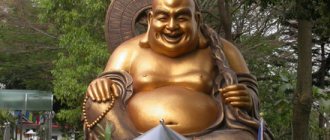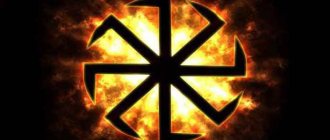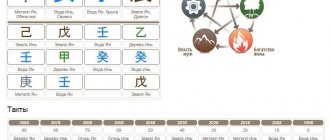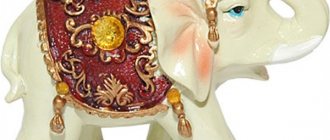From the history of Chinese coins
About 4.5 thousand years ago, barter trade began to be replaced by the “commodity-currency” system. Initially, grain or cowrie shells were used as money. Gradually they were replaced by small fragments of precious metals. Interestingly, at first neither denomination nor weight were indicated on them. The first coins that contained information about the weight of the currency and the place of its manufacture were bronze qiani - round coins with a hole inside. They were first minted in 947.
The first monetary reform in China was carried out by Qin Shi Huang. He tried to introduce a single monetary currency in the country. To purchase goods, only coins of the specified type could be used. The new money was in the form of copper discs. They had a square-shaped hole inside. This currency (its name is qian) was used in China until the mid-19th century.
China's largest currency find was discovered in the form of 10 tons of bronze qian. According to historians, this amount should have passed into the hands of the emperor of the Han dynasty (ruled after Shi Huang).
The introduction of the first paper money in China led to inflation because the currency was not backed by precious materials. The first currency called "yuan" began to be used in 1835.
The magic of attracting money!
There are no topics in this community, but it would be interesting!
Well, that's what I found about the money)))
The most ancient symbol of wealth and prosperity is the Chinese coin with a square hole in the middle.
Now in Feng Shui stores you can buy such coins of various sizes, metallic or gold color. Although these are not real coins, they still work as a Feng Shui symbol. You can put these coins in the fountain located in the wealth zone, or decorate the “ Money Tree”, which is also called the “ Tree of Happiness” with it.
This is an ordinary Crassula from the succulent family, an indoor plant with plump, rounded leaves. You can also use an artificial money tree with semi-precious stones and coins, which is a symbol of growing prosperity and wealth. It is best if there are amethyst stones on the tree. Because the Chinese believe that this mineral is capable of attracting wealth and prosperity. A “money tree” with Chinese coins and amethyst leaves can be placed in a fountain.
Place fountains and money trees in the corner of wealth, which is located in the Southeast. Simply use a compass to determine where southeast is in your apartment or room, and place the above symbols there.
In the same zone you can place any objects that you associate with wealth and money. For example, photos or pictures depicting a pile of gold or thick wads of money. Other Chinese symbols are also suitable, such as the Golden Pineapple with bars, gold bars and coins, various mobiles and pendants.
Don't buy cheap wallets. They themselves carry the energy of poverty, and serious money has almost no chance to visit them. Pay attention to the color and material from which it is made. The most suitable materials remain leather and suede, and there are not so many colors that accumulate material well-being: brown, black, gold.
Many people put photographs of loved ones in their wallet, which are also carriers of a powerful energy charge, but not financial. Moreover, photographs in a wallet can interfere with the attraction of money, and, on the contrary, the energy of money can influence the people depicted in them through photographs, and in an unpredictable direction. But it is recommended to carry special “money drives” and amulets with you, for example, a symbol of wealth and prosperity is
A Chinese coin with a square hole in the middle, put it in your wallet in the coin compartment.
Or three coins tied with a red string are placed in a wallet “ for wealth.” It is advisable that the bundles of coins that you buy in the store be packaged and undergo a preliminary cleaning procedure. Only in this case are they ready to “remember” your wishes for wealth and prosperity. If you purchased unwrapped coins, clean them by soaking them in highly salted water for 3 days. True, their appearance may change slightly.
After this, perform a special ritual: 1. find a place where you will not be disturbed
2. place three coins between your palms, concentrate and make strong wishes for prosperity and wealth for the benefit of everyone with whom you have a connection, for example, your family and friends
3. Now put the coins in your wallet or wherever you keep your money.
Envelopes for money. They must be red, they have their own favorable sizes and various hieroglyphs are applied to them. The hieroglyph “Prosperity” looks like a blooming flower. In such an envelope it is recommended to store money for current expenses in a safe, wealth corner or wherever you like. Envelopes with the hieroglyph “Wealth” are more suitable for accumulating a certain amount for something. They usually only report to it and try not to spend it. This hieroglyph resembles a box.
Having done all these simple things, perhaps you will get rich, but the main thing to remember is that the main thing is to strive for success, have a positive attitude towards good luck and high performance, then there will be money. And here's another interesting link! https://feng-shui-yasya.at.ua/publ/talismany_i_simvoly_fehnshuj/dengi_i_koshelek/2-1-0-28
What are the names of Chinese coins?
Modern Chinese can pay in stores with three types of coins:
- The official currency of China is the yuan. Until 1985, coins were made only from nickel or copper alloys. Since 1991, they began to use nickel-plated steel as a material. Since 1999 and over the course of 3 years, the design of the currency unit has been actively updated. Among local residents, the name of the coin most often sounds like “kuai” rather than “yuan”.
- Jiayu (in some regions - mao) is a monetary unit that is equal to a tenth of the yuan. From coins in China you can find denominations of money in 1 and 5 jiao, from banknotes - 1, 2 and 5 jiao. As for the material that was used to mint coins, until 1985 it was brass. Since 1991, aluminum has also been used. As in the situation with the yuan before 2002, over the course of 3 years, money was modified more than once.
- Fen is the smallest money among the Chinese: 1 jiao = 10 fen, and 1 yuan = 100 fen. This is one of the most ancient monetary units in the world, the name of which was originally used to denote a measure of weight. Most often the name is translated as “split”, but scientists present 6 more concepts of this word.
Republic of China (1912-1949)
Chinese Dollar=10 jiao; Jiao=10 cents (fen); Cent=10 cash
1 dollar 1914
silver 1 YUAN / Denomination inside the wreath Year 3 / Bust of Yuan Shikai to the left Coin price - $100-200
1 dollar undated (1927)
silver 1 YUAN / MEMENTO / BIRTH OF REPUBLIC OF CHINA / Denomination inside the wreath Sun Yat-sen head to the left Coin price - $100-200
50 fen 1942 (1942-1943)
copper-nickel alloy 50 FEN / "Kuel" Year 31 / Head of Sun Yat-sen to the left Coin price - $15-20
20 cents 1916 (1916-1922)
silver 20 FEN / Denomination in a wreath Bust of Yuan Shikai to the left Coin price - $25-30
20 cents 1922
silver Kwantung Province 20 / TWENTY CENTS / KWANG-TUNG PROVINCE
Coin price - $10-15
20 fen 1936 (1936-1939)
copper-nickel alloy 20 FEN / "Kuel" Year 25 / Head of Sun Yat-sen left Coin price - $8-10
100 cash 1913
copper Sichuan Province Coin price - $25-30
10 fen 1936 (1936-1939)
nickel 10 FEN / “Kuel” Year 25 / Head of Sun Yat-sen left Coin price - $4-6
5 cents 1923
silver Kwantung Province 5 / FIVE CENTS / KWANG-TUNG PROVINCE / Denomination in wreath
Coin price - $15-25
5 Fen 1936 (1936-1939)
nickel 5 FEN / "Kuel" Year 25 / Head of Sun Yat-sen left Coin price - $3-5
5 Fen 1940
aluminum 5 FEN / Year 29 "Kuel" Coin price - $5-7
20 cash without date (1919
) copper Hunan Province 7 hieroglyphs under the flag TWENTY CASH / THE REPUBLIC OF CHINA / Ear of wheat in a circle Crossed flags Coin price - $4-6
20 cash without date (1919
) copper Hunan Province 5 hieroglyphs under flag TWENTY CASH / THE REPUBLIC OF CHINA / Ear of wheat in a circle Crossed flags Coin price - $4-6
2 Fen 1940
brass 2 FEN / "Kuel" Chung Hua Min Kuo Year 29 / Sun Coin price - $7-10
10 cash undated ( 1919)
copper Denomination in a wreath Crossed flags Coin price - $3-4
10 cash without date (1919)
copper Denomination in a wreath Crossed flags Coin price - $3-4
10 cash without date (1920)
copper TEN CASH / THE REPUBLIC OF CHINA / Denomination in a wreath Crossed flags Coin price - $3-5
10 cash undated (1920)
copper Hunan Province TEN CASH / THE REPUBLIC OF CHINA / Ear of wheat in a circle Crossed flags Coin price - $3-4
1 Fen 1937
copper 1 FEN / “Kuel” Chung Hua Min Kuo Year 26 / Sun Coin Price - $7-10
1 Fen 1940
brass 1 FEN / "Kuel" Chung Hua Min Kuo Year 29 / Sun Coin Price - $7-10
Coins of Ancient China
The first currency in ancient China was not coins, but shells. Remains of such a “currency” were found not only in China, but also in areas where Greek colonies were located (4th century BC).
The shell coins used by the ancient Chinese were called cowries. Scientists claim that it was the Chinese who were the first to use them as money to pay for goods. Over time, the importance of such shells increased; they began to be produced in bronze, with the inscription “beat”. Only after this designation was applied was the shell considered money. Today, the inscription is used in Feng Shui and denotes trade, wealth, and successful sales.
The next stage was the production of similar coins from bronze. The first of them were slightly larger in size than modern coins, but did not yet have a round shape. They could be seen in the form of a hoe, keys, bell or shovel. They were not marked as money. Archaeologists also believe that in addition to bronze, limestone or clay, which was tightly pressed, could be used to make coins. Most of these coins were found in Chu province.
In Southern China, archaeologists have discovered modern “proto-coins” made of gold. They had the shape of a rectangle and a quadrangle. Their name already was “yuan”, but it did not yet designate the currency, but only the weight of the coins.
The first coins in Ancient China, which were similar in shape to modern ones, began to be produced in the Zhou province in the 3rd century. BC.
Coins with a hole: history and modernity
As you know, Chinese civilization gave the world many useful inventions - gunpowder and a compass, printing and paper, this is not a complete list of discoveries made on the banks of the Yangtze and Yellow River.
And few people know that completely independently and much earlier than in Europe, money appeared in China in the form of metal circles, which we now call coins. If in Europe the first coins appeared at the beginning of the 7th century. BC. and were minted from electrum (a natural alloy of gold and silver), the first Chinese coins were produced by casting bronze in stone or ceramic forms back in the 11th century BC. AD in the kingdom of Western Zhou. Currently, several coins are known with hieroglyphs denoting this kingdom.
The oldest Chinese coins. Kingdom of Western Zhou. Bronze. Drawing from the monograph by A.A. Bykov. Coins of China. – 1969
But Chinese money had an amazing feature: it had a hole. On Western Zhou coins it could be either round or square. Later, a standard was assigned to all Chinese coins for two and a half millennia - a bronze circle with a square hole in the center. This standard was finally established by Emperor Wu Di (Han Dynasty) in 118 BC.
5 shu. 118 BC Han Dynasty. Drawing from the monograph by A.A. Bykov. Coins of China. – 1969
It was then that a coin with a face value of 5 shu appeared, which became a model for many centuries. The oldest Chinese coins indicated the weight of the metal, the denomination or the city where the coin production took place, and in some cases both.
The lower part of a ceramic mold for casting 5 shu coins. First centuries AD. Shanghai Museum
Three years after the accession of the first emperor from the new Tang dynasty, namely in 621, a significant event occurred in China that influenced the entire history of numismatics both in China itself and throughout Southeast Asia. In this year, a coin with a hole in the face value of one qian was issued.
Qian. 620s. Tang Dynasty. Drawing from the monograph by A.A. Bykov. Coins of China. – 1969
The obverse of the Qiani depicts four hieroglyphs, one on each side of the hole, meaning “circulating coin of the beginning of the reign.” The reverse of these coins is usually smooth.
Chinese hole coins became the model for coin production in Korea, Vietnam, Japan and other countries in East and Southeast Asia.
Vietnamese coin of Chinese type. Kan Hung (1740-1787). Dragon in the clouds. Bronze
Thus, coins with a hole can be safely added to the list of inventions of Chinese civilization.
What was the hole in the center of the coin intended for? The answer is simple - for convenience of calculations. Since all coins with a hole until the twentieth century were cast or minted from bronze, and not from gold and silver, their face value was relatively low. Accordingly, payments in large amounts required a large number of coins - hundreds, and sometimes thousands.
A 19th-century drawing shows a Chinese man holding a bunch of coins. Drawing from the monograph by A.A. Bykov. "Coins of China". – 1969
For convenience, a certain number of coins were strung on a cord or metal rod. Such coin bundles were a means of payment for large sums of money.
Coins from the Qin Dynasty (1644-1911) strung on a metal rod. The number of coins in a bundle is 27 pieces. Height – 9.5 cm, weight – 360 g
After the overthrow of the Emperor in 1911, the Republic of China completely abandoned the minting of hole coins and switched to European coin production standards.
But Chinese civilization has always, willingly or unwillingly, shared its achievements with the rest of the world. So coins with a hole spread not only in space, but also in time. Korea, Vietnam, Japan, Laos, Thailand adopted the Chinese coin design. Hole coins were minted by European colonialists for their overseas possessions in Southeast Asia. A number of European countries still issue similar coins. Whatever you say, tradition is a terrible force.
Here are the coins of medieval Japan - mon. Only a specialist will distinguish them from Chinese ones.
1 mon. Kan'ei tsuho. Second half of the 17th century
Under the Tokugawa shoguns (early 17th century), Japan finally centralized the monetary system. The casting of bronze coins in denomination of one mon began (from 1626), weighing 3.3 g. The coin is known by the motto depicted on it - Kan'ei tsuho (the third year of the reign of Emperor Go-Mizunoo) - 寛永通寳. Coins of this type were issued until until 1870.
In the mid-1830s, Japan issued very interesting coins with an unusual oval shape.
100 mon. Tempo tsuho. Japan. 1830s
These wonderful coins are called Tempo tsuho (Japanese: 天保通寶) - “Tempo reign period”. The denomination of Tempo tsuho coins was 100 mon.
Japan abandoned the casting of coins and finally switched to European coinage principles in the second half of the 19th century.
A gear-shaped hole on a 1979 5 yen coin. Emperor Hirohito. Mint in Osaka. Brass
50 yen 2005. Emperor Akihito. Mint in Osaka. Cupronickel
However, in the Land of the Rising Sun, the tradition of minting coins with a hole continued into the 20th century. It remains the same today: some denominations continue to be issued with the traditional hole in the center.
1 satang. Siam (Thailand). King Rama VIII (1935-1946). Year 2484 according to the Buddhist calendar (1941). Bronze
At a time when Asian countries were gradually abandoning the minting of coins with a hole, in Siam (the old name of Thailand) under King Rama V in 1898, the production of satangs (1/100 baht) - small change coins with a hole - began. At the same time, a decimal monetary system was established in the kingdom. Currently, Thai coins do not have holes.
As already mentioned, in the 19th and 20th centuries, European colonialists issued a variety of denominations of coins with a hole for their overseas possessions. Sometimes, the urgent need for cash led to funny things. So in 1875, after the capture of the southeastern part of the Indochina Peninsula and the formation of the French colony of Cochin, the production of coins with a hole was established for the needs of monetary circulation.
1 sapek, converted from French centime. 1875 Colony of French Cochin
The problem had to be solved quickly, and the metropolis did not come up with anything better than to take the French regular coin of 1 centime minted by Bordeaux, and at the French military arsenal in Saigon they simply punched holes in them. Thus, with a “light movement of the hand,” the French centime turned into the Cochin sapek. A simple manipulation was required so that the local population, accustomed to Chinese-type coins, would easily and willingly accept the new money.
Hole coins were minted for numerous colonies by the largest colonial empire in history - the British.
1 cent. British East Africa. 1951 George VI. Bronze
1/10 penny. British West Africa. 1944 George VI. Cupronickel
1 penny. British colony of Rhodesia and Nyasaland. 1955-1963 Elizabeth II. Bronze
London issued coins with a hole for British East and West Africa, Rhodesia and Nyasaland, and for the “diamond in the crown of the British Empire” - India.
1 cent. Dutch East Indies. 1937 Utrecht Mint. Bronze
Holland did not lag behind its colleagues in oppressing and exploiting the colonies, issuing coins with a hole for the colonies in the East Indies (islands of the Malay Archipelago and the western part of New Guinea).
What motivated the European colonialists? Numismatic historians give two reasons. Firstly, Europeans adapted to the coinage traditions of enslaved peoples and states. Secondly, the coins of the colonies had to be different from the coins that were in circulation in the metropolis. Therefore, holes were punched in the coins, or the coin itself was irregular in shape (with a wavy edge, etc.).
The colonialists can be understood, but for what purpose some countries of the world, not related to countries with the Chinese monetary tradition, issue coins with a hole even today is not entirely clear. Perhaps a banal saving of metal?
10 lept. Greece. 1912 Nickel
20 fillers. Hungary. 1941 Coated steel
2 zlotys. Poland. Commemorative coin. 2003 Brass
1 crown. Denmark. 2007 Copper-nickel alloy
Our journey into the history and modernity of hole coins has come to an end. Having appeared in Ancient China 3000 years ago, these numismatic monuments turned out to be very “tenacious”. Many countries around the world still do not intend to give up minting such items. And numismatists have collected and continue to collect thematic collections in which the main character is a coin with a hole.
Roman Novozheev
Candidate of Historical Sciences, Associate Professor
Old Chinese coins with a hole
The bronze coin, which has a square hole (qiani), is well known in the world. They are very popular in the Middle Kingdom, not only as one of the most ancient currencies, but also as a talisman, an element of Feng Shui. Experts consider such a coin to be an object that can reunite the harmony of the earthly and the heavenly. The round shape of the coin itself is considered a symbol of the sky, the square inside is the earth that a person feels under his feet.
The two sides of the coin complement each other and are similar to Yin and Yang. Each coin has its own energy. Although this financial element has not been used for a long time, it has become the subject of research into the history of the development of the foreign exchange market in China. The most avid numismatists want to see the coin in their collection, and many simply carry it with them as a talisman that will bring good luck, health and prosperity.
Description of coins
Chinese coins are round in shape and have a square hole in the middle. The active side signifies yang energy and always contains four characters. The passive side, responsible for yin, has two symbols.
Typically these coins are made of copper. Some of them have distinctive features in the form of specific images. It could be a sword, a dragon, a phoenix. Such coins are designed to protect a person from evil forces.
Two sides of a Chinese coin with a square hole


